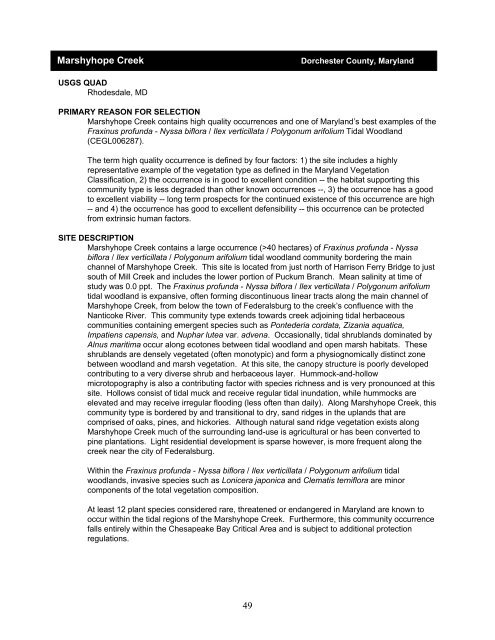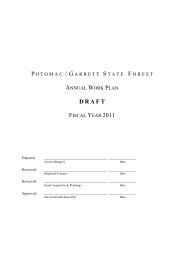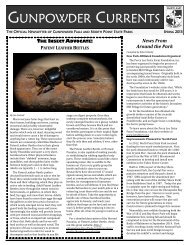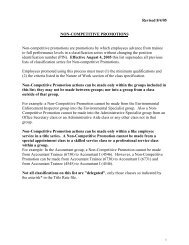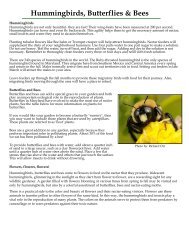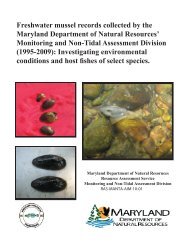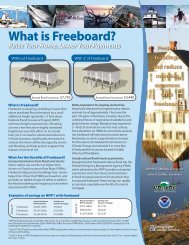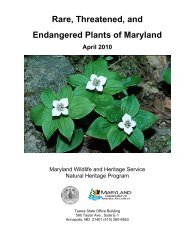tidal hardwood swamps - Maryland Department of Natural Resources
tidal hardwood swamps - Maryland Department of Natural Resources
tidal hardwood swamps - Maryland Department of Natural Resources
Create successful ePaper yourself
Turn your PDF publications into a flip-book with our unique Google optimized e-Paper software.
Marshyhope Creek Dorchester County, <strong>Maryland</strong><br />
USGS QUAD<br />
Rhodesdale, MD<br />
PRIMARY REASON FOR SELECTION<br />
Marshyhope Creek contains high quality occurrences and one <strong>of</strong> <strong>Maryland</strong>’s best examples <strong>of</strong> the<br />
Fraxinus pr<strong>of</strong>unda - Nyssa biflora / Ilex verticillata / Polygonum arifolium Tidal Woodland<br />
(CEGL006287).<br />
The term high quality occurrence is defined by four factors: 1) the site includes a highly<br />
representative example <strong>of</strong> the vegetation type as defined in the <strong>Maryland</strong> Vegetation<br />
Classification, 2) the occurrence is in good to excellent condition -- the habitat supporting this<br />
community type is less degraded than other known occurrences --, 3) the occurrence has a good<br />
to excellent viability -- long term prospects for the continued existence <strong>of</strong> this occurrence are high<br />
-- and 4) the occurrence has good to excellent defensibility -- this occurrence can be protected<br />
from extrinsic human factors.<br />
SITE DESCRIPTION<br />
Marshyhope Creek contains a large occurrence (>40 hectares) <strong>of</strong> Fraxinus pr<strong>of</strong>unda - Nyssa<br />
biflora / Ilex verticillata / Polygonum arifolium <strong>tidal</strong> woodland community bordering the main<br />
channel <strong>of</strong> Marshyhope Creek. This site is located from just north <strong>of</strong> Harrison Ferry Bridge to just<br />
south <strong>of</strong> Mill Creek and includes the lower portion <strong>of</strong> Puckum Branch. Mean salinity at time <strong>of</strong><br />
study was 0.0 ppt. The Fraxinus pr<strong>of</strong>unda - Nyssa biflora / Ilex verticillata / Polygonum arifolium<br />
<strong>tidal</strong> woodland is expansive, <strong>of</strong>ten forming discontinuous linear tracts along the main channel <strong>of</strong><br />
Marshyhope Creek, from below the town <strong>of</strong> Federalsburg to the creek’s confluence with the<br />
Nanticoke River. This community type extends towards creek adjoining <strong>tidal</strong> herbaceous<br />
communities containing emergent species such as Pontederia cordata, Zizania aquatica,<br />
Impatiens capensis, and Nuphar lutea var. advena. Occasionally, <strong>tidal</strong> shrublands dominated by<br />
Alnus maritima occur along ecotones between <strong>tidal</strong> woodland and open marsh habitats. These<br />
shrublands are densely vegetated (<strong>of</strong>ten monotypic) and form a physiognomically distinct zone<br />
between woodland and marsh vegetation. At this site, the canopy structure is poorly developed<br />
contributing to a very diverse shrub and herbaceous layer. Hummock-and-hollow<br />
microtopography is also a contributing factor with species richness and is very pronounced at this<br />
site. Hollows consist <strong>of</strong> <strong>tidal</strong> muck and receive regular <strong>tidal</strong> inundation, while hummocks are<br />
elevated and may receive irregular flooding (less <strong>of</strong>ten than daily). Along Marshyhope Creek, this<br />
community type is bordered by and transitional to dry, sand ridges in the uplands that are<br />
comprised <strong>of</strong> oaks, pines, and hickories. Although natural sand ridge vegetation exists along<br />
Marshyhope Creek much <strong>of</strong> the surrounding land-use is agricultural or has been converted to<br />
pine plantations. Light residential development is sparse however, is more frequent along the<br />
creek near the city <strong>of</strong> Federalsburg.<br />
Within the Fraxinus pr<strong>of</strong>unda - Nyssa biflora / Ilex verticillata / Polygonum arifolium <strong>tidal</strong><br />
woodlands, invasive species such as Lonicera japonica and Clematis terniflora are minor<br />
components <strong>of</strong> the total vegetation composition.<br />
At least 12 plant species considered rare, threatened or endangered in <strong>Maryland</strong> are known to<br />
occur within the <strong>tidal</strong> regions <strong>of</strong> the Marshyhope Creek. Furthermore, this community occurrence<br />
falls entirely within the Chesapeake Bay Critical Area and is subject to additional protection<br />
regulations.<br />
49


